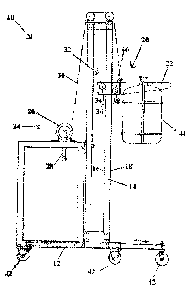Une partie des informations de ce site Web a été fournie par des sources externes. Le gouvernement du Canada n'assume aucune responsabilité concernant la précision, l'actualité ou la fiabilité des informations fournies par les sources externes. Les utilisateurs qui désirent employer cette information devraient consulter directement la source des informations. Le contenu fourni par les sources externes n'est pas assujetti aux exigences sur les langues officielles, la protection des renseignements personnels et l'accessibilité.
L'apparition de différences dans le texte et l'image des Revendications et de l'Abrégé dépend du moment auquel le document est publié. Les textes des Revendications et de l'Abrégé sont affichés :
| (12) Demande de brevet: | (11) CA 2728003 |
|---|---|
| (54) Titre français: | APPAREIL DE LEVAGE A TREUIL ET CABLE |
| (54) Titre anglais: | WINCH AND CABLE LIFTING APPARATUS |
| Statut: | Réputée abandonnée et au-delà du délai pour le rétablissement - en attente de la réponse à l’avis de communication rejetée |
| (51) Classification internationale des brevets (CIB): |
|
|---|---|
| (72) Inventeurs : |
|
| (73) Titulaires : |
|
| (71) Demandeurs : |
|
| (74) Agent: | DOUGLAS B. THOMPSONTHOMPSON, DOUGLAS B. |
| (74) Co-agent: | |
| (45) Délivré: | |
| (22) Date de dépôt: | 2011-01-17 |
| (41) Mise à la disponibilité du public: | 2012-07-17 |
| Licence disponible: | S.O. |
| Cédé au domaine public: | S.O. |
| (25) Langue des documents déposés: | Anglais |
| Traité de coopération en matière de brevets (PCT): | Non |
|---|
| (30) Données de priorité de la demande: | S.O. |
|---|
A lifting apparatus has a vertical member supported in a vertical orientation.
A
travelling lift moves up and down the vertical member. A winch and cable
system provides a
lifting force to raise the travelling lift up the vertical member. An
engagement is provided
between the travelling lift and the vertical member which includes a single
upper bearing
roller mounted to the travelling lift for rotation about a substantially
horizontal first rotational
axis and engaging a first bearing surface of the vertical member. A single
lower bearing
roller is similarly mounted to the travelling lift for rotation about a
substantially horizontal
second rotational axis. The lower bearing roller is positioned lower on the
vertical member
than the upper bearing roller and engages a second bearing surface of the
vertical member,
opposed to the first bearing surface. The described engagement is simple,
inexpensive and is
self-aligning to eliminate binding.
Note : Les revendications sont présentées dans la langue officielle dans laquelle elles ont été soumises.
Note : Les descriptions sont présentées dans la langue officielle dans laquelle elles ont été soumises.

2024-08-01 : Dans le cadre de la transition vers les Brevets de nouvelle génération (BNG), la base de données sur les brevets canadiens (BDBC) contient désormais un Historique d'événement plus détaillé, qui reproduit le Journal des événements de notre nouvelle solution interne.
Veuillez noter que les événements débutant par « Inactive : » se réfèrent à des événements qui ne sont plus utilisés dans notre nouvelle solution interne.
Pour une meilleure compréhension de l'état de la demande ou brevet qui figure sur cette page, la rubrique Mise en garde , et les descriptions de Brevet , Historique d'événement , Taxes périodiques et Historique des paiements devraient être consultées.
| Description | Date |
|---|---|
| Demande non rétablie avant l'échéance | 2017-01-18 |
| Le délai pour l'annulation est expiré | 2017-01-18 |
| Inactive : Abandon.-RE+surtaxe impayées-Corr envoyée | 2016-01-18 |
| Réputée abandonnée - omission de répondre à un avis sur les taxes pour le maintien en état | 2016-01-18 |
| Requête visant le maintien en état reçue | 2012-11-27 |
| Demande publiée (accessible au public) | 2012-07-17 |
| Inactive : Page couverture publiée | 2012-07-16 |
| Inactive : CIB attribuée | 2011-02-23 |
| Inactive : CIB en 1re position | 2011-02-23 |
| Inactive : CIB attribuée | 2011-02-23 |
| Inactive : Certificat de dépôt - Sans RE (Anglais) | 2011-02-03 |
| Inactive : Certificat de dépôt - Sans RE (Anglais) | 2011-02-02 |
| Demande reçue - nationale ordinaire | 2011-02-02 |
| Déclaration du statut de petite entité jugée conforme | 2011-01-17 |
| Date d'abandonnement | Raison | Date de rétablissement |
|---|---|---|
| 2016-01-18 |
Le dernier paiement a été reçu le 2015-01-15
Avis : Si le paiement en totalité n'a pas été reçu au plus tard à la date indiquée, une taxe supplémentaire peut être imposée, soit une des taxes suivantes :
Les taxes sur les brevets sont ajustées au 1er janvier de chaque année. Les montants ci-dessus sont les montants actuels s'ils sont reçus au plus tard le 31 décembre de l'année en cours.
Veuillez vous référer à la page web des
taxes sur les brevets
de l'OPIC pour voir tous les montants actuels des taxes.
| Type de taxes | Anniversaire | Échéance | Date payée |
|---|---|---|---|
| Taxe pour le dépôt - petite | 2011-01-17 | ||
| TM (demande, 2e anniv.) - petite | 02 | 2013-01-17 | 2012-11-27 |
| TM (demande, 3e anniv.) - petite | 03 | 2014-01-17 | 2014-01-13 |
| TM (demande, 4e anniv.) - petite | 04 | 2015-01-19 | 2015-01-15 |
Les titulaires actuels et antérieures au dossier sont affichés en ordre alphabétique.
| Titulaires actuels au dossier |
|---|
| RICHARD B. LENNOX |
| KATHARINE H. LENNOX |
| Titulaires antérieures au dossier |
|---|
| S.O. |